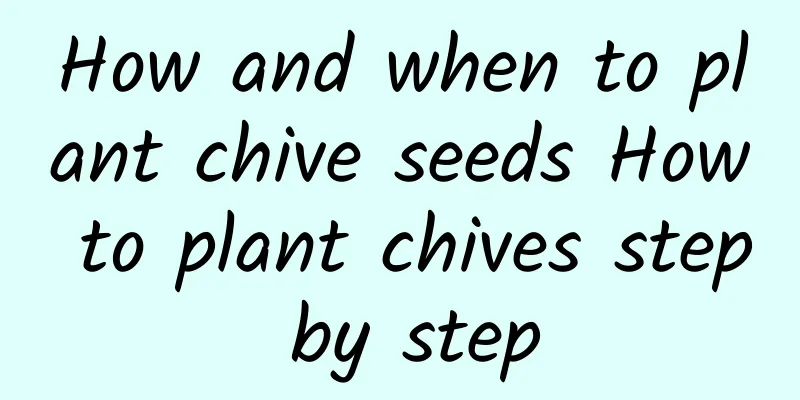Chestnut cultivation technology

|
Chestnut, as one of the main dry fruit tree species in my country, is known as the five fruits together with peach, apricot, plum and jujube. It has extremely high economic value. The fruit is sticky, soft, smooth, sweet and fragrant, and rich in nutritional value. In addition, chestnuts are rich in minerals, such as zinc, iron, potassium, etc., so they are widely loved and sought after. Let’s learn about chestnut cultivation techniques below. 1. Variety selection The key to chestnut cultivation is to select the right variety. The ideal variety should have the following characteristics: the seedlings should be more than 0.8 cm in diameter within 2 years, have strong resistance to diseases and pests, and have no damage to the roots and stems. During the planting process, the planting density should be controlled to increase the yield. Usually the spacing between plants is about 4 meters x 4 meters, and 42 plants are planted every 667 square meters. In plain areas, 36 plants can be planted per 667 square meters, and in mountainous areas , 54 plants can be planted per 667 square meters. Be sure to maintain appropriate spacing between seedlings. 2. Soil conditions Most areas are suitable for chestnut growth. The ideal environment should have the following conditions: an average annual temperature of 11-22°C and sufficient sunlight; annual precipitation of 780-950 mm, maintaining fertile soil with good water storage and drainage capabilities; choosing a sunny area with slightly acidic soil and a pH value between 5-6, ensuring sufficient sunlight while meeting the chestnut's needs for nutrients such as manganese and calcium. 3. Fertilization strategy During the growth process of chestnuts, reasonable and effective fertilization should be carried out according to the growth conditions to promote their rapid growth. During the seedling stage, long-term organic fertilizer should be applied, and fast-growth fertilizer should be added in time after the plants survive. The main topdressing methods for adult chestnuts are organic fertilizers and compound fertilizers . Organic fertilizers include biological manure, peat soil, earthworm manure, etc., which can improve soil activity, fertilizer retention, water retention, and air permeability, providing comprehensive nutrition for chestnuts. Each chestnut tree usually requires 25-30 kg of organic fertilizer. Compound fertilizer includes nitrogen fertilizer, potassium fertilizer and phosphorus fertilizer. The type of fertilizer and application time are determined according to the needs of the chestnut tree. 4. Pruning method Chestnuts have a short growing period and grow rapidly. If not pruned in time, it will affect the sunlight of the surrounding chestnut trees. It grows slowly in the seedling stage and rapidly after maturity. If pruning is not done in time, the probability of diseases and insect pests will increase, affecting the quality of chestnuts. Therefore, chestnut trees should be pruned frequently during the mature period, once every 30-60 days, and branches showing signs of diseases and insect pests should be thoroughly treated. In short, to produce high-quality chestnuts, it is necessary to continuously strengthen the cultivation technology management of fruit farmers during the planting process, reasonably control planting, variety selection, soil management, fertilization and watering management, timely prune chestnut trees, strengthen disease and pest prevention and control, and create a good growth environment for chestnut trees.
|
<<: What kind of environment does yam like to grow in? What are its requirements for soil?
>>: How to propagate hawthorn, how many years does hawthorn bear fruit
Recommend
How long does it take for June Snow cuttings to take root?
Rooting time of June snow cuttings The best time ...
How to pollinate Amaryllis
How to pollinate Understanding stamens and pistil...
What are the precautions for the methods and steps of hydroponic carrots?
The method of hydroponic carrots is relatively si...
Tips for repotting bougainvillea in summer: methods and steps for repotting
Repotting bougainvillea in summer Bougainvillea g...
Introduction of Yanfu No. 8 Apple Tree
1. Cultivation and naming It was discovered, scre...
How to plant shallots and when to plant them
Suitable time for planting shallots Shallots are ...
Lithops Varieties
1. How many varieties are there? Lithops is a com...
How to plant potatoes? The latest potato cultivation technology and management methods
Potatoes, also known as potatoes, sweet potatoes,...
Do a little “things” to these two kinds of flowers in the winter, and they will bloom just in time for the Chinese New Year, allowing you to celebrate the new year with joy!
At this season, the most important thing to do is...
What to do if the leaves of Chinese evergreen turn yellow
1. Too much light 1. Reason: Chinese evergreen is...
Bamboo's growing environment and local conditions
Bamboo Growth Environment and Conditions Bamboo p...
When and how to plant red cabbage
Planting time of red cabbage Red cabbage is gener...
What are the benefits of soda water for watering flowers? Which flowers are suitable for watering
Benefits of Soda Water for Watering Flowers Soda ...
How many catties of carrots are produced per acre
Carrot yield per mu Generally speaking, the yield...
Taboos of growing camellia in winter
Not too little light Although this flower is a se...









